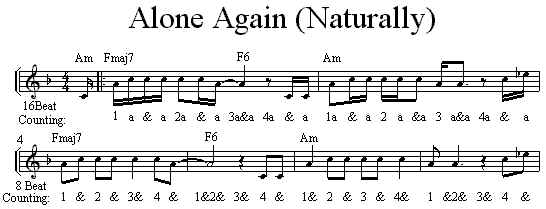ah 1 and ah 2 and ah 3 ...
When you are playing a song from printed music, you need to be able to recognize not only the note value (C, G, Bb, etc) but also the timing of that note. Simpler songs use only whole notes (4 beats), half notes (2 beats), and quarter notes (1 beat). If the song is in 4/4 time, all you need to do is be able to count to 4 to translate the notes into the timing the composer wanted. Consider the music from Any Time presented below.

This example has only simple notes. The time signature - C - is the same as saying 4/4 , i.e. 4 quarter notes per measure. The intro only has two notes, so we start counting at 3. If you are playing an 4 measure intro on your keyboard, count each measure of the intro. When you get to the fourth measure, start the song on beat 3. I have grouped the numbers you should be counting under each note. You must count evenly with the rhythm and start each note on the appropriate count number.
8 Beat Counting
The above example is not very hard, but what happens when you get music that is shorter than 1 beat. A single quarter note can be replaced by two eighth notes, so a measure that has 4 quarter notes, could also have 8 eight notes in it. And, of course, these can be combined in any combination. An eighth note followed by a quarter note followed by an eighth note must take up the same amount of musical time as a single half note or two quarter notes.
To account for these extra notes, instead of counting 1 - 2 - 3 - 4 for each measure, you count out eight times by adding an & (and) in between each major beat: 1 - & - 2 - & - 3 - & - 4 - &. Use this technique for After You've Gone shown below. The first measure starts with 4 eight notes. Give each of the first three notes one (of your 8) beats: 1- & -2 . The fourth note is tied to the remaining half note. It gets all the rest of the beats: &3&4&.

In the second measure you encounter a dotted quarter note. That means you increase the timing of the note by one half. A dotted quarter is the same as a quarter note PLUS an eight note. Just as a dotted half note is the same as a half note PLUS a quarter note. Using your 8-beat counting scheme, it is now easy to sound out the timing of the second measure. Starting out with an eight note rest (1), the next four notes get a single count each (& - 2 - & - 3). The final note, gets the rest of the counts (&4&). If you play this slow, counting each note so you get the right timing, eventually your ears will recognize how the tune should sound and you will be able to play it without any counting at all.
16-Beat Counts
The music for some of today's modern songs can look pretty intimidating. Consider the first two measures from Alone Again (shown below). Here we see a lot of 16th notes. With sixteenth notes, you will want to count 16 times per measure. Use this formula:
1 - a - & - a - 2 - a - & - a - 3 - a - & - a - 4 - a - & - a
You are adding an "a" in between each of the counts in the 8-beat pattern. I have added to counts to where the lyrics would be in the first line of the music sample below. If you count slowly and carefully as you play the notes, you will hear the melody as it is written.

While the original music can look difficult, consider the second line of music shown above. It doesn't look as hard. But it is exactly the same music. The only difference is how it is written. In line two, everything is slowed down by replacing, in effect, quarter notes with half notes. Listeners won't detect any difference; the song will still sound correct, but it may be easier for you to learn this way.
I find that this counting can be very valuable to hear what the melody should sound like. By listening carefully as you play, your ears will learn what the melody should be. After awhile, you'll get a feel for the piece and you will be able to play it without counting.
This page updated on May 20, 2021 .